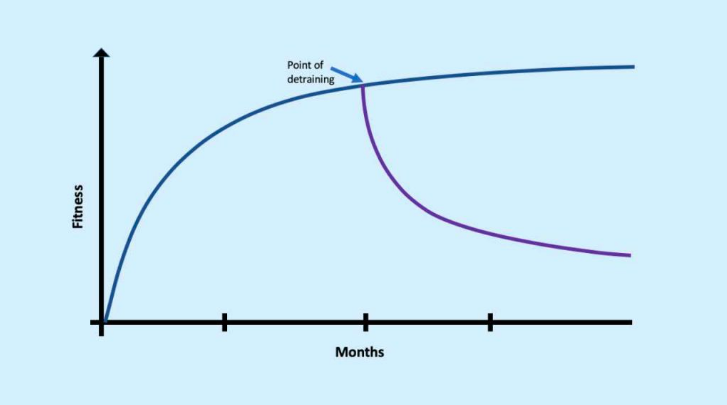Endurance athletes often face the apprehension of losing their hard-earned fitness during training breaks, whether chosen or involuntary. This concern is partly valid, as research suggests that a decline in fitness can occur after approximately two weeks without training. In this article, explore the concept of detraining, discover the factors that accelerate performance loss, and learn effective methods to mitigate its effects.
Training interruption
During the sports career of a cyclist or triathlete, it is inevitable that, at some point, a break from training must be taken, whether forced or voluntary. The reasons may be varied: an injury, a trip, a post-race recovery period, a seasonal break or simply a reduction in the training load. In many cases, a recovery period is a positive thing and can be important for future training. So you should take advantage of rest days or the off-season.
Endurance athletes often grapple with a significant fear: the potential loss of their hard-earned fitness due to a break. But the question remains: is this fear justified?
What is detraining and what happens in our body
Let’s take a step back and first try to understand what ‘detraining’ means. Detraining is a partial or total loss of the training-induced adaptation that the body has achieved, as a result of the reduction or interruption of training.
When we train, our lungs and heart become more efficient at supplying oxygen and pumping blood through the body. VO2max (i.e. the maximum amount of oxygen that can be taken in during exercise, transported to the cells and finally utilised) increases, as does the oxidative capacity of skeletal muscle.
So what happens when we take an extended break from training? VO2max and aerobic capacity begin to decrease (due to the reduction in maximum cardiac output), as do muscle strength, flexibility, and speed. We see changes in blood pressure, blood sugar and cholesterol levels. The body begins to lose the ability to utilise carbohydrates efficiently and the muscles find it harder to process oxygen. This sounds like a tragic situation, but it is less serious than it seems.
How quickly does it take to lose aerobic fitness?
There is no precise rule on this, as the drop in performance is individual and is linked to many factors. However, studies and research have shown that for endurance athletes, performance losses are most pronounced after two weeks of inactivity (in the first two, a reduction of only around 6% occurs). Between 4 and 9 weeks without training, losses range from 8% to 20% of VO2max (the data are relative, because we lose a percentage of our physical level). This happens because the heart pumps less blood with each beat, and therefore less oxygen reaches the muscles. The most immediate losses concern enzyme levels, glycogen accumulation and muscle efficiency.
Unfortunately, aerobic fitness is the quickest to be lost in sport. However, as already mentioned, it takes around two weeks before you see any noticeable effects. So if you want to take a long weekend, a break or a holiday, it won’t take you too long to get back to your previous level when you return.
The drop is rapid in the first 2-4 weeks, but then tapers off over time. After 3-4 months after stopping training, you return to your basic fitness.

Professional athletes initially experience a more rapid decline in VO2max levels, but in the long term they will maintain their basic fitness for longer. Thanks to their experience in achieving high mileage levels, they will also be able to recover faster than a beginner. So if you have been training for a long time, your basic cardiovascular fitness will remain intact for months. Several years of running allow you to build up a solid aerobic base.
What about muscular strength? In general, muscle power is maintained longer than aerobic power. It can take up to four weeks before we see major reductions (again depending on individual factors). In running or cycling, strength is used particularly during intervals. Sprinters and power athletes can therefore return to their pre-pause fitness more quickly than others.
Factors influencing detraining
1. BIOLOGICAL ELEMENTS
Age is a key factor. The older you get, the more quickly your body will be affected by detraining. No significant differences have been shown between males and females. The natural basic build also plays a role (height, mass, bone and muscle development…).
2. BASIC PHYSICAL FITNESS
The speed of detraining effects is closely related to the level of physical fitness you had before stopping. The more trained you are, the less rapidly you will see a drop in training performance (in the long term). It is very important here to create a solid base in the off season, where you try to optimise your body’s ability to adapt to new training stimuli. The better the base = the lower the loss
3. THE REASON FOR TAKING A BREAK
The reason why you take a break is also a factor: if it is a forced break due to injury or illness, then the drop in performance will be more noticeable. The reason is that you will probably do little exercise, and your body will suffer the additional stress of the injury and the regeneration process.
On the contrary, if you choose to pause your training for a break or embark on a trip, your body will reap the benefits of reduced stress and pressure from illness. And your days will probably not be as sedentary as in the previous case.
How to alleviate detraining?
1. STAY IN MOTION
Try to keep your body moving throughout the day. It is always better to do little than nothing. A few stretching exercises, free weights, a walk or hike, or even gardening: there are many ways to incorporate physical activity into your daily routine.
2. alternative TRAINING
If your body allows it, try to incorporate alternative forms of exercise into your daily routine: rowing, trekking, aqua jogging, yoga, strength training…. But be careful: in case of injury, always consult a doctor before starting exercises that may do more harm than good.
If you are not injured, simply try to find activities that can increase your heart rate, even if only for 10 minutes.
3. KEEP AN OPEN MIND
The mental aspect also plays a role: when returning after a training break, many people over- or under-estimate their fitness. Our tip is to resume training without too many expectations, but at the same time with confidence and an open mind. Listen to your body, resume gradually and don’t worry if it is hard at first, you will regain your shape faster than you think.
You might also be interested in:
Heat and performance loss: how much do cyclists and triathletes lose?
Create a training plan for triathlon, cycling, and running based on artificial intelligence with 2PEAK that adapts to your performance after each training. Download the app and start revolutionizing your training.


